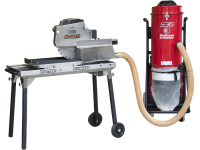Innovations dust-free working
TNO has been connecting people and knowledge for 80 years to create innovations that, among other things, sustainably enhance the well-being of society. In the field of dust-free working, TNO has pioneered a multitude of solutions that have reduced the exposure of employees and have greatly increased ease of use. In addition, work is being done on the development and application of sensors and digitization to better map exposure with the aim of taking preventive measures. Some examples are mentioned below and can also be found in the overview of solutions.
With new technologies and developments, such as sensors and digitization, it becomes possible to determine exposure in high resolution in time and place. TNO is working on a Virtual Occupational Hygiene Assistant that will bring personal and automated preventive measures within reach.
Welding releases many harmful substances such as welding fumes, chromium and nickel. Application of a welding booth designed by TNO leads to a reduction in exposure.
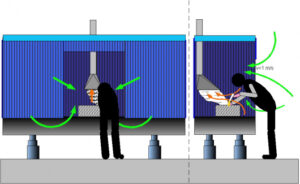
TNO has developed several sanding booths for aircraft maintenance on behalf of KLM and the Ministry of Defense with the aim of minimizing exposure to hexavalent chromium.
The design is based on the separation of dirty and clean zones and the supply of clean air in the employees’ work zone. Working in the designed sanding booth leads to a lower exposure than working in the original sanding booths.
The design is schematically shown in the figures below.
In the first figure the various components (supply plenum, cabin, discharge plenum, locks, technical room, air treatment installation) are schematically shown. The personal locks are a physical separation between dirty and clean work areas. From the cabin (dirty area) the employee goes through the walk-in shower (cleaning work clothes by brushes with extraction). Then the dirty work overalls are removed in the lock. The employee goes through the air shower to the clean lock and then leaves the cabin.
The bottom figure schematically shows the configuration of the selected air treatment system with filter systems.
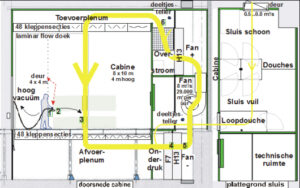
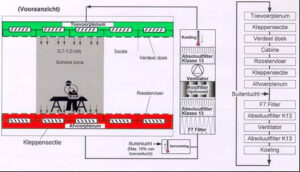
Commissioned by the Ministry of Security and Justice, TNO has conducted research into the air quality at indoor shooting ranges during target practice (dynamic shooting).
Shooting releases many potentially harmful substances, including copper, carbon monoxide and gadolinium oxide. To protect both shooters and instructors against these substances, TNO has designed a push-pull ventilation system. The use of this ventilation system results in a reduction of exposure.
For more information see TNO report TNO-DV 2011 C301 (on request)
Dust extraction on hand tools
TNO has developed various prototypes for dust extraction on tools with various market parties.
The dust released during operations such as drilling, sanding, grinding, sawing, etc. is sucked away directly at the source by industrial vacuum cleaners. This reduces the exposure of employees to, among other things, respirable dust, hardwood and chrome.
The emission of respirable dust to the employee and work environment is reduced by the use of an on-tool extraction system.
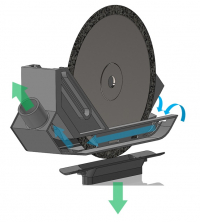
The figure below shows the TNO basic design of a multicyclone unit for the effective capture of respirable quartz particles from an air stream. The unit can be used to remove contaminated air from technical production areas (and breathing zone of employees).
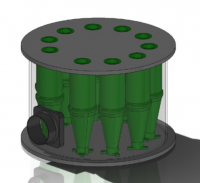
Especially for building materials that easily absorb water (sand-lime brick, brick, different types of natural stone (sandstone), a saw table with a water supply can reduce the emission of dust compared to dry sawing. TNO has made a design for water supply.
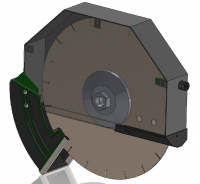
Working with an angle grinder can lead to high dust emissions. TNO has developed a dust cover with which exposure can be reduced to below the limit value.
The image below shows the dust cover for angle grinders developed by TNO.
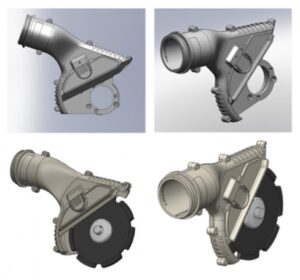
The figure below shows the design of an extraction system attached to a combination hammer. This innovation results in substantially lower emissions compared to working without the extraction system.
The image below shows the extraction adapter for combination hammers developed by TNO.
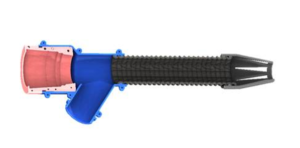
In collaboration with Translas and iTanks, TNO has developed a welding torch with integral welding fume extraction.
Due to the integral welding fume extraction, 90 – 95% of the welding fumes are effectively extracted directly at the source in all welding positions. This innovation welding torch won the 2015 EARTO Innovation Prize in the Impact Delivered category.
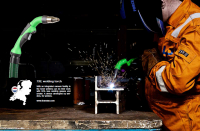
The use of an integrated dust extraction on a saw table provides a greatly reduced exposure to dust than working without such extraction.
